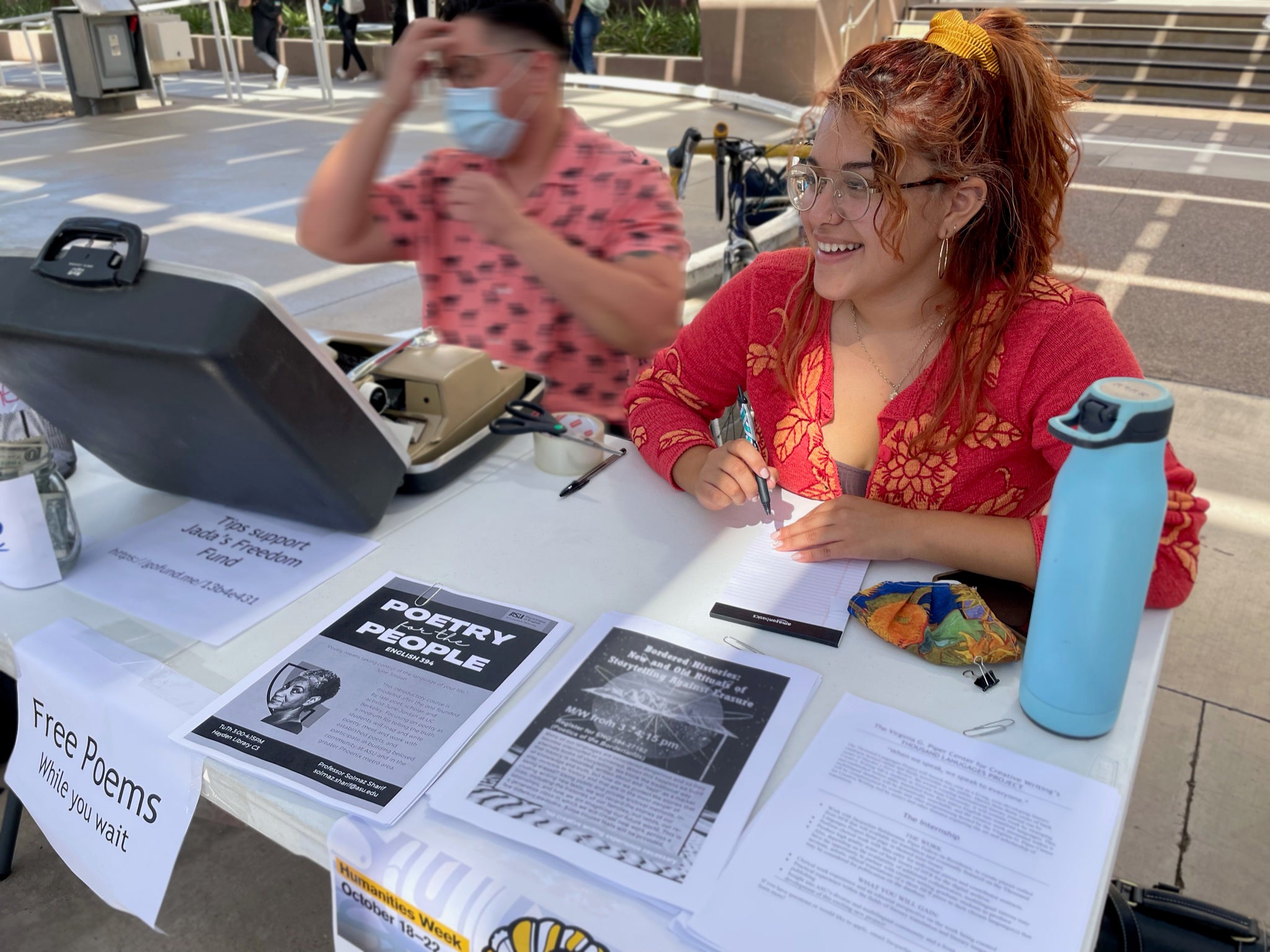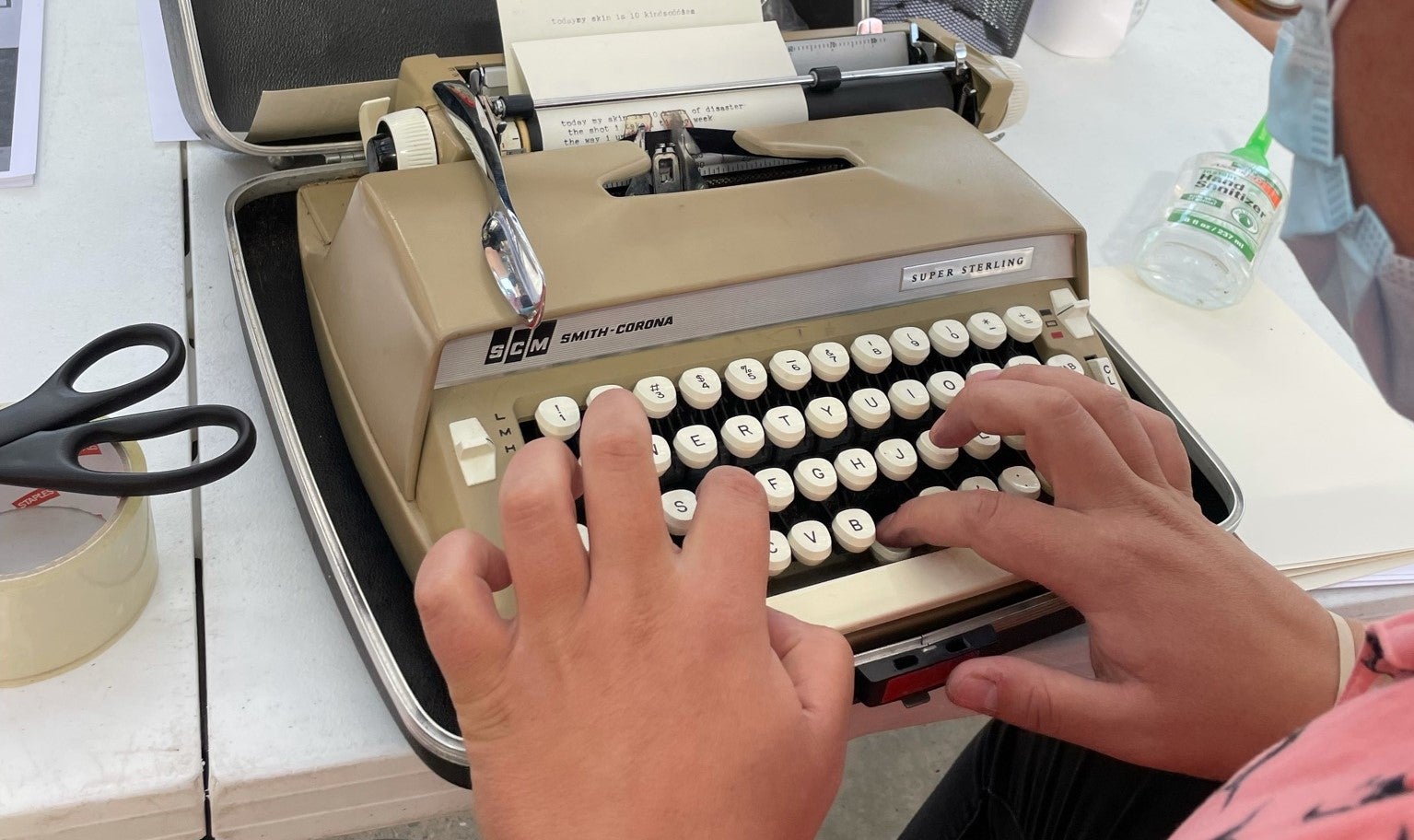In 2021, ongoing social, environmental and economic upheavals have made sifting through the noise — sometimes metaphorical noise, sometimes literal noise — an unfortunate part of daily life. How to determine what’s worth your time? What’ll make you spiral versus make you soar? And what’s that sound?
New for spring 2022, a set of courses from the Department of English at Arizona State University will provide a positive outlet for existential angst. From poetry for the people, to writing for social change, to speculating on the future, to analyzing sports media, these courses won’t add to the questions, they’ll answer them.
Registration information for these and a sampling of other fall semester classes is provided below. Find more in the ASU class schedule (search by “ENG,” “FMS,” “LIN” or “APL” prefixes), searchable by both online and in-person options.
1. ENG 394: Poetry for the People
ASU creative writing students M. McDonough and Aida Campos participate in a Humanities Week event on the ASU campus on Oct. 19. Photo courtesy of Sally Ball
What it is: Modeled on the blueprint of June Jordan’s revolutionary UC Berkeley program, ENG 394: Poetry for the People at ASU is a lecture and workshop series that introduces a variety of poetic forms and traditions. Focused on bridging the divide between the academy and community, students write their own poems while exploring the ethical and political possibilities of poetry. Throughout the semester, poets visit the class to read and speak on their role as a poet in the world.
Why it matters: Poetry’s unique ability to say a lot with a little is a primary source of its power. Poetry for the People demonstrates the art form’s applicability in everyday life while naming the sociohistorical realities that underpin it.
Who’s in charge: Poet and ASU Assistant Professor Solmaz Sharif teaches this course as a master class in speaking truth and sharing it with others. Sharif, who is the author of the National Book Award finalist “Look” (2016) and the former managing director of the Asian American Writers’ Workshop, studied and taught with Jordan’s Poetry for the People at UC Berkeley.
Who should take it: ENG 394 is open to undergraduates of any major with an interest in literature, poetry, language, writers and writing, community engagement, activism, ethics or politics who have met basic first-year composition requirements.
If you register: ENG 394 Poetry for the People (class # 20576) meets Tuesdays from 3–4:15 p.m. on ASU’s Tempe campus. Students must also register for a recitation section.
2. ENG 494: Chicana/o/x Futures: Prophecies, Science Fiction and Other Speculative Ruminations
San Francisco’s Mission District is filled with inspiring murals painted by local artists, many of them Chicano. Photo by Fabrice Florin on Flickr (used under CC 2.0)
What it is: What does the future hold? Is it a utopian moment where all humanity comes together? Will the challenges of today metastasize into a dystopian nightmare? And if it is the latter, what are we to do now? ENG 494: Chicana/o/x Futures will explore these questions primarily through Chicano cultural texts, such as “La Raza Cósmica,” “Lunar Braceros,” “High Aztech,” “The Last Generation,” “The Rag Doll Plagues,” “Sleep Dealer,” and more.
Why it matters: The future is now! Also, reading sci-fi can really help articulate and navigate our fears about the future.
Who’s in charge: Professor of English Lee Bebout, an affiliate faculty in the School of Transborder Studies, teaches this course. Bebout is the author of the books "Whiteness on the Border: Mapping the U.S. Racial Imagination in Brown and White" (2016) and “Mythohistorical Interventions: The Chicano Movement and its Legacies” (2011).
Who should take it: ENG 494 is open to any undergraduate with an interest in writing, reading, fiction, science fiction, speculative futures, literature, language, communication, culture, media, technology, Latino identity or diaspora studies who has met basic first-year composition requirements.
If you register: ENG 494: Chicana/o/x Futures (class # 30834) is offered Tuesdays and Thursdays from noon–1:15 p.m. on ASU’s Tempe campus.
3. FMS 360: Sports Media
Brandon Marshall, a linebacker for the Denver Broncos, kneels in protest as the cameras roll during the singing of the national anthem at a game in 2016. Photo by Jeffrey Beall on Wikimedia Commons (used under CC 4.0)
What it is: Commercial sports and the media have long enjoyed a symbiotic relationship. Sport has been featured in hundreds of films, boosted television viewership and provided a generation of fans a continuously streaming pastime on the internet. This course will survey the history of the connection between sports and media, with emphasis on the technological and economic favors that sports has been granted. In addition, students will explore how media representations of athletes comment on larger issues in American society.
Why it matters: The hundred-billion-dollar sports media industry is worthy of a closer look; the informed consumer can make reasoned choices about where to spend time, money and social capital.
Who’s in charge: Professor Aaron Baker, a film and media studies specialist, teaches this course. Baker is the author of “Contesting Identities: Sports in American Film” (2003) and the editor of “Out of Bounds: Sports, Media and the Politics of Identity” (1997). His newest book, “The Baseball Film: A Cultural and Transmedia History,” is forthcoming in 2022.
Who should take it: FMS 360 is open to any undergraduate with an interest in film, television, digital culture, media and marketing, internet gaming, business, sports, race, gender, politics, technology, communication or writing who has met language or film course prerequisites; see course catalog for details.
If you register: FMS 360: Sports Media (class # 30749) meets Tuesdays and Thursdays from 3–4:15 p.m. on ASU’s Tempe campus.
4. ENG 598: How to Teach Shakespeare
ASU student Noah Brown recites a speech from Shakespeare's "Henry V" at a Mary Lou Fulton Teachers College fair outside the Memorial Union in 2016. Photo by Charlie Leight/ASU News
What it is: This course covers strategies for lifting Shakespeare from “tired” to “wired” in the secondary and college-level classroom. Designed to build confidence in teaching the Bard’s plays to Gen Z learners, students will learn different types and modes of instruction in a practical, fun and hands-on atmosphere.
Why it matters: Right. So you’ve heard the controversy over Shakespeare. He’s dead, he’s white, his language is glitchy. Is he still worth classroom time? This course’s answer is a resounding “yes.”
Who’s in charge: Regents Professor Ayanna Thompson, who directs the Arizona Center for Medieval and Renaissance Studies and created RaceB4Race, is the course’s instructor. Thompson is the author of “Shakespeare in the Theatre: Peter Sellars” (2018) and co-author of “Teaching Shakespeare with Purpose: A Student-Centred Approach,” among other performance and literary studies.
Who should take it: How to Teach Shakespeare is ideal for in-service language arts and drama teachers and any graduate student with an interest in literature, education, language, literacy, theater or communication.
If you register: ENG 598: How to Teach Shakespeare (class # 30702) meets Tuesdays from 4:30–7:15 p.m. on ASU’s Tempe campus.
5. ENG 494: Writing for Social Change
A student uses a manual typewriter to type a custom poem during a Humanities Week event Oct. 19 on ASU's Tempe campus. Photo courtesy of Sally Ball
What it is: Climate change. Affordable health care. The income gap. Food insecurity. What are the issues and concerns that call you to action? ENG 494: Writing for Social Change offers a rhetorical approach to understanding and using writing to participate in social change, highlighting the often “behind the scenes,” or invisible, rhetorical work on which such efforts depend. Each student researches a concern that they consider deserving of broader attention and action, identifies the conditions that have created and/or perpetuated this concern, and designs elements of an infrastructure that is responsive to the complexity of that concern.
Why it matters: Who doesn’t have a cause they’d like to champion, if only they knew how? Writing really can play a role in solving problems and bringing about significant social change.
Who’s in charge: Professor Shirley Rose, former director of ASU’s Writing Programs and an authority on activist rhetorics, is this course’s instructor. Rose is most recently the co-author of “The Internationalization of U.S. Writing Programs” (2018) and “Going Public: What Writing Programs Learn from Engagement” (2010).
Who should take it: Writing for Social Change is open for any undergraduate with an interest in writing, advocacy, activism, politics, social justice, creative nonfiction, rhetoric, literacy, communication or media and marketing who has met basic first-year composition requirements.
If you register: ENG 494: Writing for Social Change (class # 25610) meets Tuesdays and Thursdays from noon–1:15 p.m. on ASU’s Tempe campus.
6. ENG 414: Studies in Linguistics: Multimodal Discourse Analysis
Creative writing student Erin O'Malley speaks during a Humanities Week event Oct. 19 on the ASU campus. Photo courtesy of Sally Ball
What it is: Don’t be fooled by the complicated title; ENG 414 makes interpreting meaning a clear process. Examining various “modes” of media, from television to visual art, from video games to social platforms, students will learn how to analyze many kinds of text and talk, from speaking to the role of not speaking, from participants’ body language to the colors of fashion. The course will approach various “texts” from a critical perspective of their representation of identities, location and many other expressions of meaning.
Why it matters: The ability to separate substance from style — and meaning from mode — is a skill that will come in handy, no matter a student’s career path.
Who’s in charge: Professor Karen Adams, a sociolinguist, teaches this introduction to discourse analysis. Most recently, Adams is the author of “Mediated Campaign Debate Subgenre and Their Importance for Analytic Considerations” in the 2018 volume “Doing Politics: Discursivity, Performativity and Mediation in Political Discourse” and researches genres such as “talking head” shows and street signs.
Who should take it: ENG 414 is open to any undergraduate with an interest in language, linguistics, rhetoric, communication, writing, culture or other related fields who has met language course prerequisites; see course catalog for details.
If you register: ENG 414: Multimodal Discourse Analysis (class # 19878) is offered Tuesdays and Thursdays from 4:30–5:45 p.m. on ASU’s Tempe campus.
This list is just a sampler of what you can explore in the Department of English at ASU, a unit in the humanities division of The College of Liberal Arts and Sciences, during spring 2022. Taught by award-winning faculty from myriad specialties, the courses cross disciplinary boundaries and are designed to reach students where they are.
Top photo: Aida Compos writes in a spiral during a Humanities Week event on the ASU Tempe campus Oct. 19. Photo courtesy of Sally Ball
More Law, journalism and politics

Annual John P. Frank Memorial Lecture enters its 26th year
Dahlia Lithwick, an MSNBC analyst and senior legal correspondent at Slate, is the featured speaker at the School of Social Transformation’s 26th annual John P. Frank Memorial Lecture on…

The politics behind picking a romantic partner
A new study reveals the role that politics play when picking out a romantic partner — particularly for older adults.“Findings show that politics are highly salient in partner selection across gender…

Tips to make tax season less taxing
When it comes to highly unpleasant experiences, filing taxes is probably up there with root canals — which is why people put off doing them. But tax season is here, and in an effort to alleviate…








